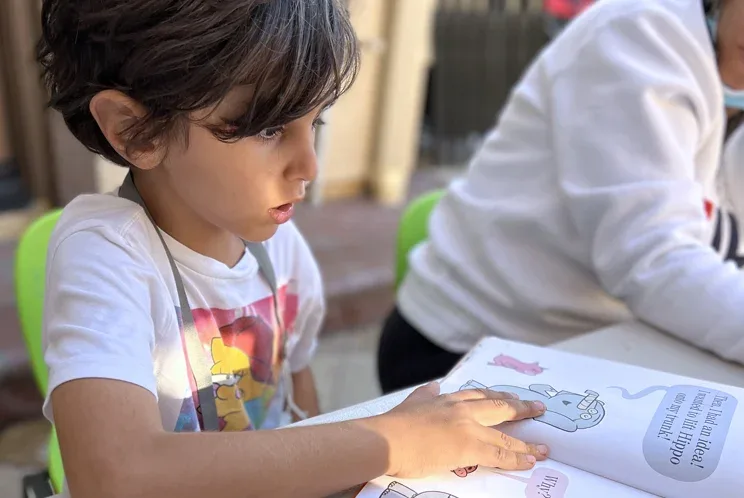
Imagine a toddler confidently saying “thank you” in English, counting in Spanish, or singing a rhyme in Mandarin. These early language experiences aren’t just adorable, they’re powerful. During the early years, a child’s brain is especially wired to absorb language, making this the ideal window to introduce multiple languages or strengthen foundational communication skills.
In this post, we’ll explore the practical benefits of early language learning, how it supports brain development, and why integrating language education sets children up for long-term academic and social success.
Contents
- 1 Early Language Acquisition in Young Children
- 2 What Are the Cognitive Advantages of Early Language Learning?
- 3 Social and Emotional Benefits of Language Learning in Child Development
- 4 Academic and Future Career Implications of Early Language Learning
- 5 Cultural Awareness and Global Perspective
- 6 Practical Strategies for Parents and Educators
- 7 Addressing Common Myths and Concerns About Early Language Learning
- 8 FAQs: Early Language Learning and Development
- 8.1 What are the benefits of language development in early childhood?
- 8.2 Why is it important to learn a foreign language at an early age?
- 8.3 What Is the Best Age to Introduce a Second Language?
- 8.4 Can Children Differentiate Between Two Languages?
- 8.5 How Can Non-Bilingual Parents Support Language Learning?
- 9 Final Thoughts on Early Language Learning for Lifelong Success
Early Language Acquisition in Young Children
The early years of a child’s life, especially from birth to age 5, are considered a critical window for language development because the brain is highly adaptable and responsive during this time.
This flexibility, known as neuroplasticity, allows young children to easily absorb new sounds, words, and grammar rules, often by simply being exposed to language through conversation, play, or storytelling.
According to the Critical Period Hypothesis, there is an optimal time frame during which the brain is most efficient at learning language, after which this ability gradually declines. Early childhood is the best time to introduce native and additional languages, laying a strong foundation for communication, literacy, and cognitive development.
What Are the Cognitive Advantages of Early Language Learning?
One of the most well-documented benefits of early language learning is its powerful impact on brain function, particularly in strengthening memory, improving attention span, and enhancing problem-solving skills.
Improved Memory and Attention Span from Early Language Exposure
Children who learn a second language early often show stronger working memory and better attention control than their monolingual peers. Switching between languages requires the brain to focus, ignore distractions, and store information actively, skills directly tied to the brain’s executive functions.
For example, a bilingual child listening to a story in one language and responding in another is exercising both short-term memory and mental flexibility. These cognitive tasks strengthen neural pathways involved in focus and information retention, which benefits overall learning across subjects.
Enhanced Problem-Solving Skills Through Bilingual Language Learning
Early language learners also tend to outperform their peers in tasks that require reasoning, categorization, and pattern recognition. Learning a new language forces children to make connections between words, sentence structures, and meanings, often using context to fill in gaps or interpret new information.
This constant mental exercise boosts their ability to analyze situations from multiple perspectives and consider different solutions. For instance, understanding that the same object can have different names depending on the language reinforces abstract thinking, foundational for effective problem-solving and critical thinking in both academic and real-world scenarios.
Social and Emotional Benefits of Language Learning in Child Development
Language learning plays a crucial role in child development by enhancing a child’s ability to connect with others emotionally and socially. By mastering new languages, children gain words and insights into different cultures and ways of thinking, deepening their interpersonal skills and emotional intelligence.
This early exposure strengthens social connections and supports literacy development, as children become more skilled at recognizing sounds, understanding vocabulary, and interpreting meaning across different languages.
Building Empathy Through Multilingualism
When children learn multiple languages, they are exposed to diverse perspectives and cultural contexts. This exposure helps them understand and appreciate differences, fostering empathy and cultural sensitivity. For example, a child who speaks both Spanish and English may better grasp the emotions and values of people from different backgrounds, leading to more compassionate interactions.
Strengthening Communication Skills
Language proficiency enhances a child’s ability to express thoughts, emotions, and needs clearly and appropriately. Multilingual children often develop more nuanced vocabulary and greater flexibility in communication, allowing them to navigate social situations and articulate complex feelings effectively and confidently. This skill is essential for building healthy relationships and resolving conflicts.

Academic and Future Career Implications of Early Language Learning
Early language learning doesn’t just influence childhood; it sets the stage for success throughout education and professional life. Children who develop language skills early tend to have stronger academic foundations and greater adaptability, which can translate into better career prospects in an increasingly globalized economy.
Academic Performance and Literacy
Research shows that children exposed to multiple languages from a young age often outperform their peers in literacy and other academic areas. Early language skills improve reading comprehension, vocabulary, and critical thinking, which boost overall academic achievement. These advantages help students excel in subjects beyond language arts, including math and science.
Career Opportunities in a Globalized World
Multilingualism is a highly valued skill in today’s interconnected world. Proficiency in multiple languages can open doors to international business, diplomacy, healthcare, technology, and education careers. Early language learners are better positioned to work across cultures, negotiate effectively, and access broader professional networks, giving them a competitive edge in the job market.
Cultural Awareness and Global Perspective
Learning multiple languages from an early age acts as a bridge to diverse cultures, allowing children to connect deeply with different traditions and ways of life. This exposure fosters cultural appreciation and respect, helping young learners understand perspectives beyond their own.
By engaging with various languages, children develop open-mindedness and a broader worldview, which encourages empathy and adaptability, essential qualities in our increasingly global society.
Practical Strategies for Parents and Educators
Supporting a child’s language development requires intentional, hands-on methods that integrate language learning naturally into daily routines. Parents and educators can use specific techniques to make language acquisition engaging and effective, promoting steady progress in communication skills.
For families seeking a high-quality early childhood education experience, child care centers offer comprehensive programs tailored to each developmental stage, from toddlers to preschoolers.
Interactive Reading and Storytelling
Reading aloud with children while asking questions about the story encourages active participation and improves comprehension. Using picture books, asking children to predict what happens next, or discussing characters’ feelings expands their vocabulary and critical thinking.
Storytelling also introduces new sentence structures and expressions in a memorable context, making language learning more meaningful.
Incorporating Music and Songs
Singing songs with repetitive lyrics and catchy melodies helps children internalize new vocabulary and understand pronunciation patterns. Nursery rhymes and songs teach rhythm and intonation, vital for natural speech flow. Music also makes language fun and memorable, increasing motivation and retention, especially when combined with actions or dance.
Engaging in Everyday Conversations
Regular, meaningful conversations throughout the day, whether during meals, play, or routines, offer practical opportunities for children to practice language in context. Talking about what they see, feel, or plan to do encourages expressive language skills and vocabulary growth, responding to children’s questions, expanding their sentence models, and encouraging more complex speech.
Addressing Common Myths and Concerns About Early Language Learning
Many parents and educators have concerns about early language learning that are based on misunderstandings. Addressing these myths helps create a more informed approach, encouraging confident support for bilingual or multilingual children.
Myth 1: Bilingualism Causes Confusion
It’s a common misconception that learning two or more languages simultaneously confuses children. In reality, bilingual children develop separate language systems in their brains and can distinguish between languages early on. This ability strengthens cognitive flexibility, helping them switch between tasks more easily rather than being confused.
Myth 2: Delayed Speech Due to Multiple Languages
Children exposed to multiple languages might experience delayed speech development. While bilingual children might take slightly longer to start speaking, this delay is usually temporary. Over time, they catch up and often outperform monolingual peers in language skills, benefiting from increased mental flexibility and communication abilities.

FAQs: Early Language Learning and Development
What are the benefits of language development in early childhood?
It improves communication, cognitive skills, social interaction, and lays the foundation for academic success.
Why is it important to learn a foreign language at an early age?
Early learning takes advantage of brain plasticity, making it easier to master pronunciation, vocabulary, and grammar.
What Is the Best Age to Introduce a Second Language?
Early exposure, even from infancy, is ideal due to heightened brain receptivity.
Can Children Differentiate Between Two Languages?
Yes, children can distinguish and switch between languages with ease.
How Can Non-Bilingual Parents Support Language Learning?
They can enroll their child in bilingual daycare centers, use language classes, apps, and bilingual books, and encourage regular practice through play and conversation.
Final Thoughts on Early Language Learning for Lifelong Success
Starting language learning in early childhood offers a wide range of cognitive, social, and cultural benefits that shape a child’s future success. From enhancing memory and problem-solving skills to fostering empathy and global awareness, early language exposure builds a strong foundation for lifelong growth.
Parents and educators can confidently support children in becoming proficient, open-minded communicators by addressing common myths and using practical strategies. Embracing language learning early is not just an educational choice; it’s an investment in a child’s ability to thrive in an interconnected world.
Do you have thoughts or questions about early language development? Comment below. We’d love to hear your experiences or insights. Your perspective could help other parents and educators support children’s language learning journey!

